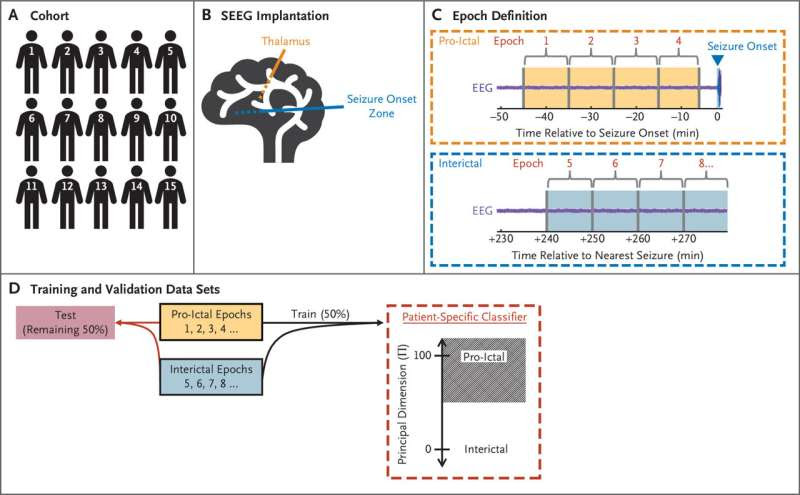by University of Texas Health Science Center at Houston

(Panel A) Patients with medically refractory temporal lobe epilepsy undergoing stereo-electroencephalography (SEEG) for presurgical workup of epilepsy were included in this study (N=15). (Panel B) Each participant provided informed consent for electrode implantation into the thalamus for research purposes. EEG data from the seizure onset zone and thalamus were captured during the inpatient monitoring period. (Panel C) The EEG was divided into: (1) pro-ictal epochs, beginning 5 minutes before seizure onset and extending 40 minutes retrograde; and (2) interictal epochs, defined as all time points 4 hours removed from the nearest seizure. Epochs were further divided into 10-minute, nonoverlapping windows, which are illustrated as numbered (i.e., 1–8), bracketed EEG segments. (Panel D) Epochs were randomly distributed into training and validation cohorts in a 1:1 ratio. For each participant, a classifier used the training data to reduce EEG-based measures to a real-valued principal dimension, Π, in which pro-ictal and interictal states were assigned scores near 100 and 0, respectively. Training data were used to optimize the classifier’s parameters. Subsequently, the optimized classifier’s performance was assessed by using the held-out validation data. Both training and testing were performed in a patient-specific fashion. Credit: NEJM Evidence (2023). DOI: 10.1056/EVIDoa2200187
Seizures can be predicted more than 30 minutes before onset in patients with temporal lobe epilepsy, opening the door to a therapy using electrodes that could be activated to prevent seizures from happening, according to new research from UTHealth Houston.
The study, led by Sandipan Pati, MD, associate professor in the Department of Neurology with McGovern Medical School at UTHealth Houston, was recently published in NEJM Evidence.
“The ability to predict seizures before they occur is a major step forward in the field of epilepsy research,” said Pati, senior author of the study and a member of the Texas Institute for Restorative Neurotechnologies at UTHealth Houston Neurosciences. “These findings are significant because they suggest that we may be able to develop more effective therapies for epilepsy, which could greatly improve the quality of life for patients who suffer from this condition.”
Surgery is a common treatment for many patients with epilepsy. But when seizures affect larger areas of the brain, removing part of the brain surgically is not an option. Neuromodulation therapy could offer an alternative solution for patients with these seizures, Pati said.
Past studies of continuous electroencephalography (EEG)—the measurement and recording of electrical activity in different parts of the brain—have suggested that seizures in people with focal-onset epilepsies tend to occur during periods of heightened risk, represented by pathologic brain activities known as “pro-ictal states.” The EEG-based detection of pro-ictal states is critical to the success of adaptive neuromodulation, with the early detection of seizures allowing electrodes to be applied therapeutically to the brain’s seizure onset zone and thalamus.
To distinguish these pro-ictal states, Pati’s team studied a prospective, consecutive series of 15 patients with temporal lobe epilepsy who underwent limbic thalamic recordings in addition to routine intracranial EEG for seizure localization. In total, they analyzed 1,800 patient hours of continuous EEG.
The researchers were able to detect pro-ictal states in patients with temporal lobe epilepsy at least 35 minutes before seizure onset. Pro-ictal states were distinguished at least 45 minutes before seizure onset in 13 of 15 participants. In two of 15 participants, they were distinguished up to 35 minutes prior.
While Pati believes that modulation of these brain regions during pro-ictal periods may be an effective therapeutic approach to the treatment of temporal lobe epilepsy, his theory still needs to be tested in clinical trials. However, this information could lead to the development of electrical or drug therapies aimed at preventing seizures.
“This study was made possible by the collaboration of a team of experts in neurology, neurosurgery, and neuroscience,” he said. “It highlights the importance of interdisciplinary research in advancing our understanding of brain disorders.”
Temporal lobe epilepsy is the most common seizure disorder, affecting some 50 million people globally. There are two temporal lobes, one on each side of the head behind the temples. Mesial temporal lobe epilepsy, which accounts for about 80% of all temporal lobe seizures, involves seizures starting in or near a part of the brain called the hippocampus, which controls memory and learning. Neocortical or lateral temporal lobe epilepsy involves seizures starting in the outer section of the temporal lobe.
Omar A. Alamoudi, Ph.D., postdoctoral research fellow in the Department of Neurology with McGovern Medical School at UTHealth Houston, contributed to the study. Other co-authors included Adeel Ilyas, MD, and Kristen O. Riley, MD, both with the University of Alabama at Birmingham.

Leave a Reply